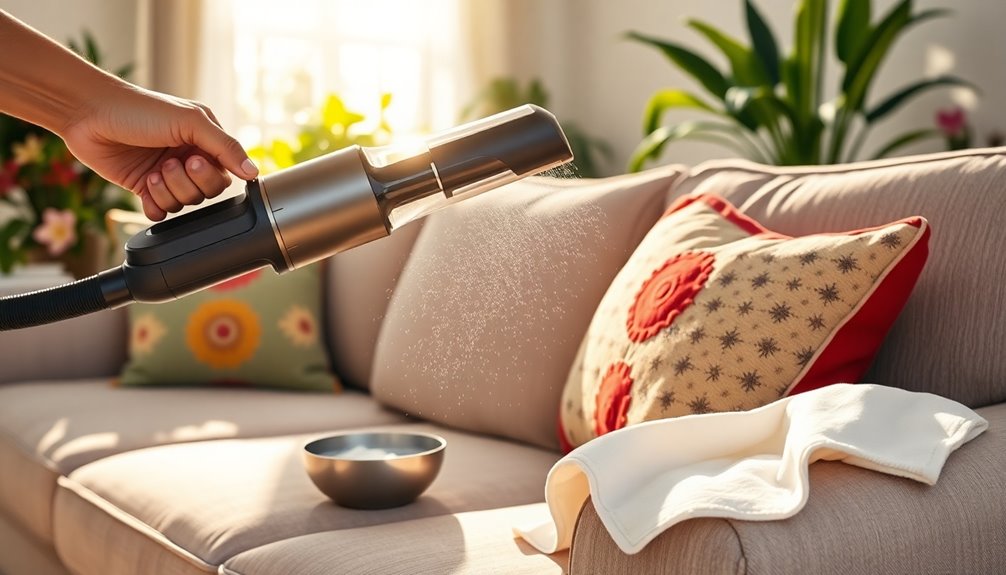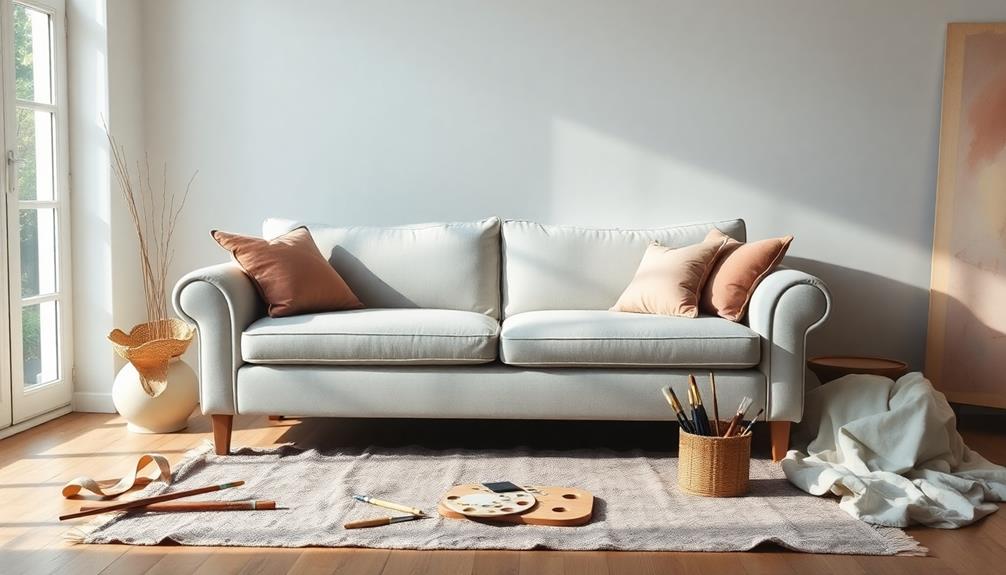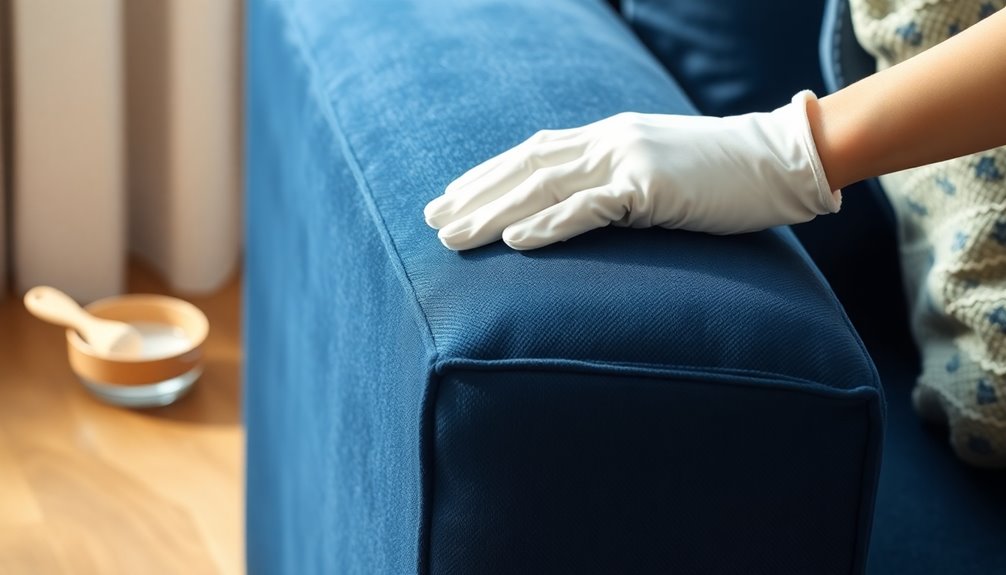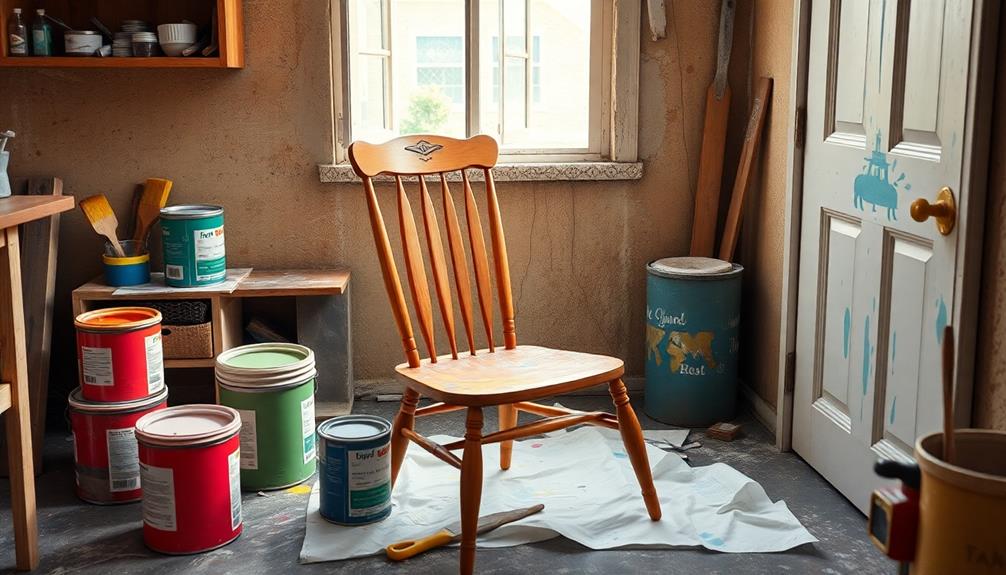To clean your sofa at home, start by vacuuming it every 3-4 weeks with an upholstery attachment. Dust surfaces with a microfiber cloth before you vacuum. If you have spills, act quickly to blot them up. For fabric sofas, mix dish soap and water for spot cleaning, while rubbing alcohol works for microfiber. Check the care label for specific cleaning instructions. You can also refresh the fabric by sprinkling baking soda and vacuuming it up. For more detailed techniques on maintaining your sofa’s beauty and comfort, there’s plenty more to explore! If you find that your sofa is beyond cleaning and is in need of replacing, consider removing an old sofa before bringing in a new one. Donating or recycling the old sofa can be a more sustainable option than simply throwing it away. Many charities accept gently used furniture, and there are recycling programs available for sofas that are no longer in good condition. By responsibly removing an old sofa, you can make room for a fresh, clean, and stylish new piece of furniture in your home.
Key Takeaways
- Establish a regular cleaning schedule, vacuuming every 3-4 weeks and using a microfiber cloth to dust before vacuuming.
- Check the fabric care tags to determine the appropriate cleaning method, either water-based or solvent-based.
- Act quickly on spills by blotting with a clean cloth and using a suitable cleaning solution for the specific stain.
- Utilize removable and washable cushion covers to simplify cleaning and maintain appearances; wash according to care instructions.
- Apply a fabric protector spray every 6-12 months to repel stains and ensure easier cleanup for your sofa.
Introduction
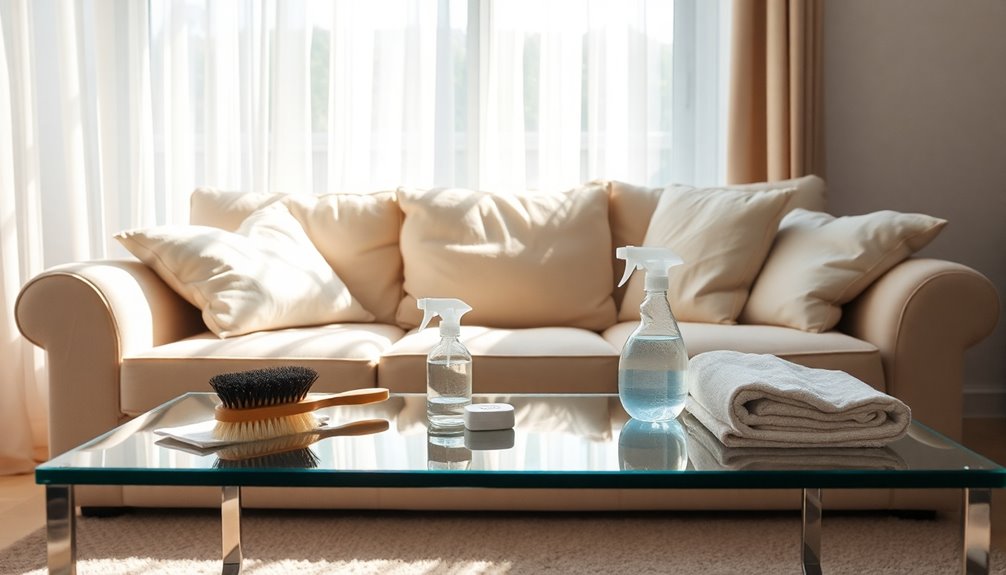
Keeping your sofa clean is essential for both its appearance and your home's air quality. You'll want to focus on routine vacuuming and dusting, along with fabric-specific cleaning techniques to tackle everyday messes. If you spill coffee or wine, knowing how to eliminate those stains quickly will help maintain your sofa's freshness.
Routine Vacuuming and Dusting
A clean sofa not only looks great but also extends the life of your furniture. To keep your upholstery in top shape, establish a routine cleaning schedule. Aim to vacuum your sofa every 3-4 weeks, especially if you have pets or experience heavy usage. This prevents dirt buildup and prolongs the fabric's life.
Start by using an upholstery attachment on your vacuum cleaner. This tool effectively removes dust, crumbs, and pet hair from all surfaces, including those tricky crevices and under detachable cushions. Before you vacuum, dusting with a microfiber cloth or soft brush can help loosen and eliminate debris, enhancing overall cleanliness.
Don't forget to pay special attention to those detachable cushions. Remove them and vacuum both sides to eliminate hidden dirt and allergens. For quick clean-ups between deep cleaning sessions, a lint roller can be your best friend; it efficiently tackles pet hair and small debris on the sofa's surface. Additionally, incorporating regular grooming into your pet care routine can significantly reduce shedding and help keep your sofa cleaner. By incorporating these routine vacuuming and dusting practices, you'll maintain a fresh and inviting sofa that you and your guests will love.
Fabric-Specific Cleaning Techniques
When it comes to cleaning your sofa, understanding the specific needs of its fabric is essential. Different fabric upholstery requires unique cleaning methods to maintain their appearance and durability. Always check the cleaning tag on your sofa; it'll guide you on whether to use water-based cleaning (marked with a "W") or solvent-based cleaning (marked with an "S"). For a DIY couch cleaner, a mix of dish soap, vinegar, and warm water works well on cloth couches, while microfiber needs rubbing alcohol for effective stain removal.
Suede couches benefit from gentle brushing and a damp cloth, while velvet should be vacuumed weekly and treated with steam for wrinkles. For leather, regular cleaning involves wiping with a microfiber cloth and using a specialized leather cleaner in small sections—don't forget to condition it to keep the leather looking its best.
Before using any cleaning solution, always perform a spot test on an inconspicuous area. This step is crucial to prevent any discoloration or damage. Following these fabric-specific cleaning techniques will ensure your sofa stays fresh and inviting.
Eliminating Coffee and Wine Stains
Even with careful cleaning, accidents happen, and coffee or wine spills can leave unsightly stains on your sofa. Don't panic; you can tackle those coffee and wine stains effectively. For coffee stains, your first step is to immediately blot the stain with a clean cloth to absorb any excess liquid. Avoid rubbing, as it can spread the stain further. Next, create a cleaning solution using 2 cups of distilled water, 1 tablespoon of dish soap, and 1 tablespoon of white vinegar. Apply this mixture with a damp cloth, blotting the area until the stain lifts.
For wine stains, start by gently blotting with a paper towel to soak up the liquid. Sprinkle salt on the stain to absorb moisture, and after a few minutes, vacuum it up. A solution of club soda can also help lift the color—simply apply it and blot with a clean cloth. Always remember to test any cleaning solution on an inconspicuous area of the fabric first to ensure it won't cause discoloration or damage. With these tips, your sofa will look fresh and clean in no time!
Applying Fabric Protector Spray
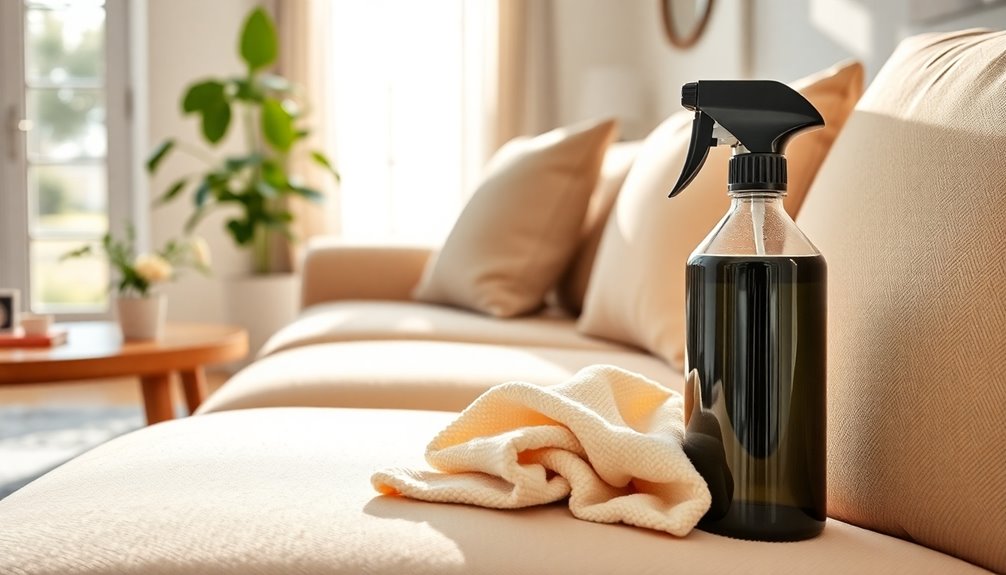
Applying fabric protector spray is just one way to maintain your sofa's look and longevity. You should also consider using durable fabric options, adding stylish throw blankets, and regularly rotating your cushions to further enhance protection. Together, these strategies help keep your sofa looking fresh and extend its lifespan.
Using Durable Fabric Options
A fabric protector spray acts as a shield for your sofa, repelling stains and spills while making cleanup a breeze. To keep your couch looking fresh, it's crucial to choose a fabric protector specifically designed for the durable fabric on your upholstery. Delicate materials like silk or leather may not be safe to use with certain sprays, so always check the label.
Before applying the fabric protector, ensure your sofa is clean and completely dry. This step maximizes the effectiveness of the spray, helping create a strong barrier against water and other stains. Follow the manufacturer's instructions closely, including application techniques and recommended drying times, to achieve the best results.
Regularly reapplying the fabric protector every 6-12 months will help maintain its protective qualities, ensuring your sofa remains stain-resistant and odor-free. Additionally, this proactive approach can significantly prolong the lifespan of your upholstery. By taking these steps, you'll not only keep your couch looking great but also simplify your upholstery cleaning routine. Creating an organized environment enhances the effectiveness of your fabric protection efforts, allowing you to enjoy your sofa worry-free! So go ahead, protect your investment and enjoy your sofa worry-free!
Opt for Stylish Throw Blankets
Throw blankets not only add a cozy touch to your living room but also serve as a practical solution for protecting your sofa. They can effectively guard against spills and stains, ensuring your upholstery stays fresh and beautiful. Choose stylish throw blankets that complement your decor while being functional.
To enhance protection, consider applying a fabric protector spray. This creates a barrier against liquids and dirt, making cleaning up accidents a breeze before they set into your upholstery. When selecting a fabric protector, ensure it's designed specifically for your sofa's material to guarantee compatibility and effectiveness.
Regular maintenance is crucial, so reapply the fabric protector every 6 to 12 months, or follow the product's instructions. This routine keeps your sofa looking its best and extends its lifespan. Additionally, opt for machine-washable throw blankets made from durable materials; they'll make cleaning and maintenance easy.
Incorporating throw blankets into your living space not only elevates your decor but also provides a functional layer of protection for your sofa. With the right combination of style and practicality, you can enjoy a beautiful, long-lasting piece of furniture.
Regularly Rotate Cushions
Regularly rotating your cushions is essential for maintaining the shape and comfort of your sofa. By doing this, you help distribute wear evenly, which extends the lifespan of your furniture. Cushions that aren't rotated can become lumpy and uncomfortable, affecting your overall seating experience. Aim to rotate your cushions every few weeks to keep them in top condition.
In addition to rotating, applying a fabric protector spray is a smart move. This spray adds an extra layer of defense against stains and spills, making cleaning easier and more effective. It's best to apply the protector every 6 to 12 months, depending on how much wear your sofa experiences, especially if you have pets or kids.
Before applying, test the fabric protector on a hidden area first to ensure it's compatible with your upholstery. This step prevents any potential discoloration. Using a fabric protector significantly reduces the need for deep cleaning since it stops dirt and spills from penetrating the cushions. By regularly rotating your cushions and using a protector, you can enjoy a cleaner, more comfortable sofa for years to come.
Cushion Replacement Strategies
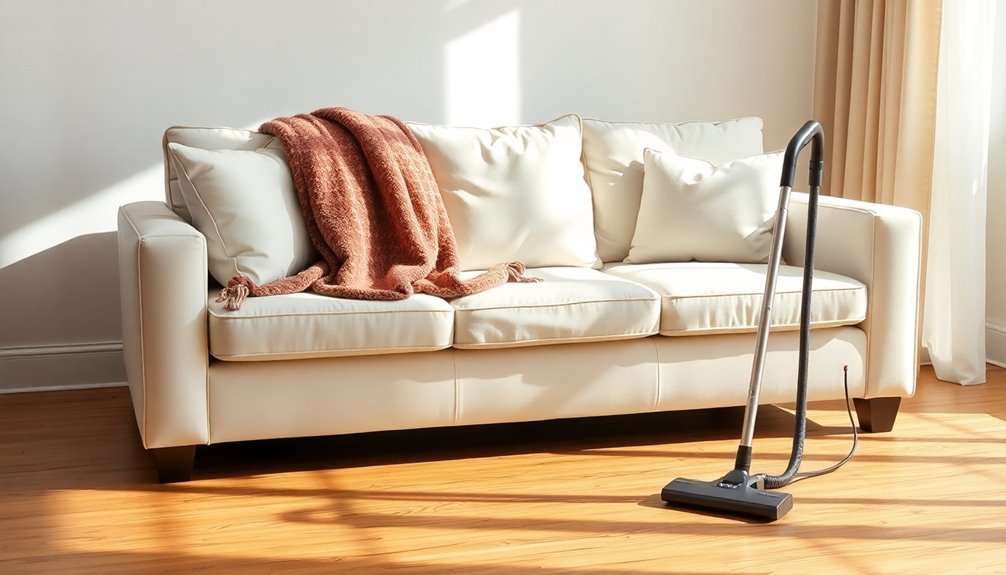
If your couch cushions are sagging and losing support, it might be time to consider replacements. Start by assessing their condition and exploring techniques to recondition the fabric for a refreshed look. Choosing the right materials can help revitalize your cushions, making your sofa comfortable and inviting again. In addition to reconditioning the fabric, it’s important to consider the filling of the cushions. Look for high-quality foam or stuffing that will provide durable support for years to come. You may also want to consider investing in cushion inserts or padding to give your sofa an extra boost. When shopping for replacement cushions, be sure to research the best materials and options available to find the best vibrators for women that meet your specific needs.
Cushion Sagging and Support
To combat cushion sagging and enhance support, consider replacing the foam in your sofa with high-density options that offer improved durability and comfort. High-density foam not only lasts longer but also provides the firmness needed to prevent sagging. Additionally, adding a cushion support board underneath your couch cushions can help distribute weight evenly, further enhancing support.
Regularly rotating and flipping your cushions is another effective strategy to maintain their shape and prevent uneven wear. This practice extends the life of your sofa and ensures that all areas receive equal pressure over time. If you're looking for a budget-friendly solution, consider adding a layer of polyester batting or a mattress topper to enhance comfort without the need to replace the foam entirely.
If your sofa has removable and washable covers, cleaning them can refresh their appearance and help maintain the integrity of the cushions, which may also reduce sagging over time. By taking these simple steps, you'll not only improve the support of your couch but also enhance your overall sitting experience.
Couch Fabric Reconditioning Techniques
Your sofa's fabric can significantly impact its overall look and feel, so reconditioning it not only revitalizes your space but also extends the life of your furniture. Start by assessing your cushions; if they're permanently stained, compressed, or lost their shape, it's time to replace them. Choosing high-density foam or down alternatives for your replacement cushions will provide better support and longevity, ensuring your upholstered furniture feels as good as it looks.
Consider using removable and washable cushion covers. This makes cleaning easier and keeps your sofa fresh and hygienic. When you replace cushions, make sure they match the original dimensions and firmness to maintain the aesthetic and comfort of your couch.
If you prefer a DIY approach, you can re-stuff cushions with polyester fiberfill or foam inserts. This method allows you to restore shape and comfort without the need to replace the entire piece of furniture. By following these cleaning tips and cushion replacement strategies, you'll keep your couch fabric looking great and feeling inviting for years to come.
Revitalize Your Couch Cushions
Revitalizing your couch cushions can breathe new life into your living space, making it more inviting and comfortable. Start by assessing the condition of your cushions regularly. Look for thinning fabric, lumps, or loss of shape to determine if it's time for a replacement. If so, consider high-density foam or down alternatives for better support and longevity.
Opt for removable cushion covers that can be machine washed or spot cleaned. This makes cleaning easier, especially if you have pets that leave stains behind. For a more comprehensive solution, think about reupholstering your cushions. Choose durable fabrics like washed linen or eco-nubby textures that withstand wear and tear, which also facilitates deep cleans.
If you want a tailored fit, explore custom cushion replacement services. You can select specific dimensions and firmness levels to enhance comfort. By taking these steps, you'll not only revitalize your couch cushions but also improve the overall aesthetic of your home, making it a cozy haven for everyone. Regular maintenance, similar to automotive repair practices, helps prevent costly issues in the long run. So, roll up your sleeves and give your sofa the attention it deserves!
Cushion Covers With Unique Patterns

Often, cleaning cushion covers with unique patterns requires a bit of extra care to preserve their vibrant designs. Start by checking the care label for specific cleaning instructions, as different materials may have unique codes like W, S, WS, or X. If your cushion covers are machine washable, use cold water and a gentle cycle to prevent fading and distortion of the pattern. Remember to avoid bleach or harsh detergents, which can damage the fabric and alter colors.
For cushion covers that aren't machine washable, you'll need to spot clean them. Mix a mild detergent with water and gently apply it using a cloth, ensuring you don't scrub too hard to protect the intricate designs. After washing, always air dry your patterned cushion covers. High heat from a dryer can shrink the fabric and ruin those beautiful unique patterns. By following these steps, you'll keep your cushion covers looking fresh and vibrant, enhancing the overall aesthetic of your sofa. With a little extra attention, your patterned cushion covers can remain a stunning focal point in your living space.
Upholstery Maintenance for Longevity
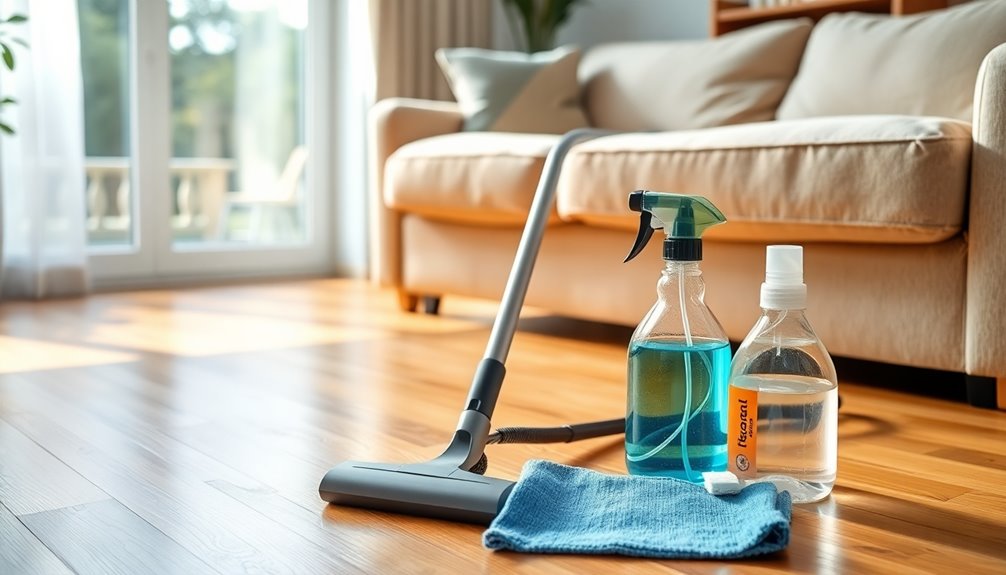
To ensure your upholstery lasts for years, regular maintenance is key. Start by cleaning your couch every 12 to 18 months. This routine maintenance not only enhances its appearance but also preserves the fabric's integrity by preventing dirt buildup. Use a vacuum cleaner with a brush attachment to reach crevices and detachable cushions, removing dirt and pet hair that can wear down the fabric over time.
Always check the care label for specific cleaning instructions. Different fabrics require different methods—knowing whether your upholstery is W, S, WS, or X will help you avoid damage. For minor spills, act quickly to remove stains; this can significantly reduce the need for a deeper clean later.
Incorporating baking soda into your routine can also be beneficial. Sprinkle it on the upholstery, let it sit for a while, and then vacuum it up. This not only refreshes the fabric but also neutralizes odors, contributing to a cleaner indoor environment. By staying on top of these tasks, you'll keep your upholstery looking great and extend its lifespan.
Conclusion
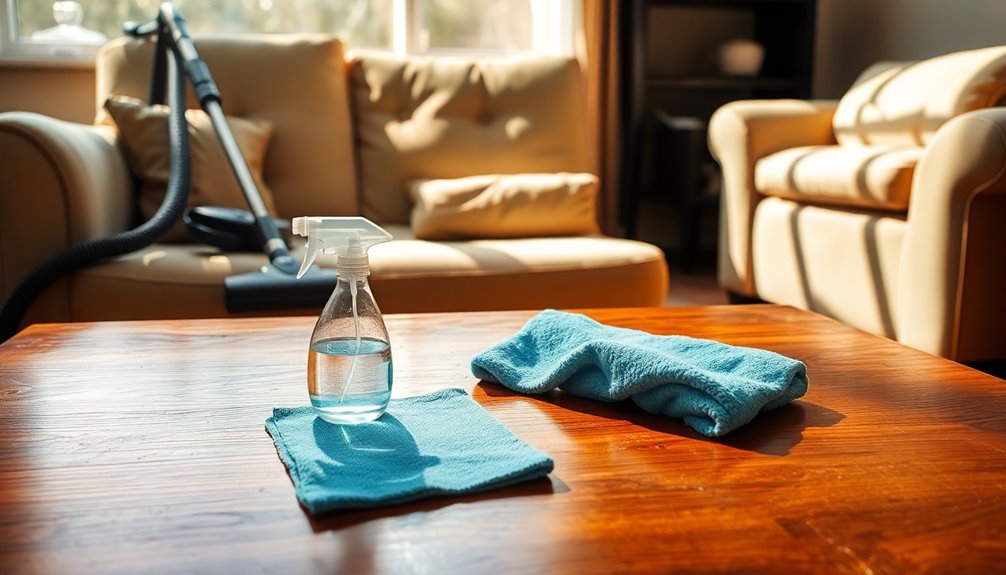
Maintaining your sofa is vital for keeping it looking fresh and beautiful for years to come. To achieve this, make sure you're regularly vacuuming your couch every 3-4 weeks. This simple step helps prevent dirt buildup and extends the life of your upholstery. Deep cleaning your sofa every 12 to 18 months is also essential, particularly if you have pets or heavy usage.
Always check the cleaning label before you start; knowing the fabric will guide you on the best cleaning methods to avoid damage. For everyday cleaning, a mild dish soap mixed with water can work wonders, and for deeper issues, consider using a steam cleaner. Additionally, using an air purifier can help enhance the overall air quality in your home by reducing allergens and odors.
If your sofa has stubborn pet smells or tough stains, don't hesitate to call in a professional cleaner with upholstery experience. They can thoroughly deep clean your couch while ensuring it looks its best. Additionally, using natural solutions like baking soda and vinegar can help eliminate odors without harsh chemicals. By following these tips, you'll keep your sofa looking great and enhance the air quality in your home.
Frequently Asked Questions
What Is the Best Way to Clean a Fabric Sofa?
To clean a fabric sofa effectively, start by checking the care label for cleaning codes. Vacuum thoroughly using an upholstery attachment to eliminate dust and debris. If your fabric is water-safe, mix distilled water, dish soap, and vinegar for stains. For solvent-safe fabrics, use a designated cleaner after spot testing. Regularly vacuum and address spills immediately to keep your sofa looking fresh and prolong its lifespan. You'll notice a significant difference!
How Can I Deep Clean My Couch at Home?
To deep clean your couch at home, start by vacuuming it thoroughly, including under the cushions. Check the fabric care tag for cleaning instructions. If it allows water, mix two cups of distilled water with a tablespoon of dish soap and vinegar, then blot stains with a damp microfiber cloth. For tougher stains, consider steam cleaning, but always do a spot test first. Let it dry completely before applying baking soda to absorb odors.
How to Clean a Couch by Yourself?
To clean a couch by yourself, start by checking the care label for cleaning codes. Vacuum the entire couch, paying special attention to crevices and under cushions. For fabric couches, mix distilled water, dish soap, and vinegar to spot clean stains. If you've got a microfiber couch, use rubbing alcohol on stains. Finally, sprinkle baking soda to eliminate odors; let it sit, then vacuum it up for a fresh, clean smell.
How Do You Clean a Fabric Couch Without Washing It?
To clean a fabric couch without washing it, start by vacuuming thoroughly with an upholstery attachment to remove dust and debris. Sprinkle baking soda over the surface to neutralize odors, letting it sit for 15-30 minutes before vacuuming again. For stains, use a DIY solution of water, dish soap, and vinegar on a damp cloth to gently blot. Finally, maintain your couch's appearance by regularly brushing it with a stiff brush or lint roller.
